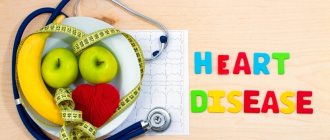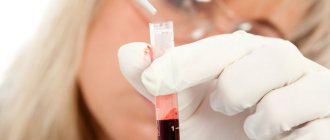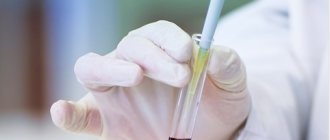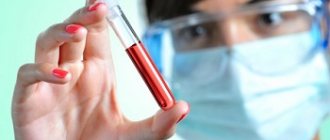Why is it necessary to do a lipid profile?
The content of the article
A lipidogram allows you to assess the risk of developing plasma atherosclerosis even with normal levels of total cholesterol.
A lipidogram or lipid profile includes the study of the following indicators:
- triglycerides;
- total cholesterol;
- low density lipoproteins - LDL;
- high density lipoproteins - HDL.
Their values provide information about the state of lipid metabolism and metabolic disorders and, therefore, about the risk of developing atherosclerosis and cardiovascular complications, such as:
- Coronary artery stenosis and myocardial infarction;
- Stroke.
Factors in the development of atherosclerosis:
- elevated lipid levels - triglycerides, total cholesterol and LDL fraction;
- lower HDL cholesterol levels;
- hypertension;
- smoking;
- diabetes;
- increased levels of fibrinogen, homocysteine;
- obesity;
- poor diet rich in saturated fats;
- low physical activity;
- old age.
Lipid profile indicators. How to take the test correctly and what affects the result?
Laboratory diagnostics doctor of the clinical diagnostic laboratory Kapustina E.V.
When going for any research or analysis, we all want to get the correct and most reliable result, and in the case of a lipidogram , as with other analyses, you need to know and follow some rules so as not to distort the indicators.
The blood lipid spectrum is very sensitive to external conditions. This doesn't just apply to food intake. The results can be affected by anxiety, excessive exercise, taking medications, having recently had other tests, drinking alcohol the night before the test, infections, etc., so all these factors need to be kept in mind.
It is recommended to take blood samples for lipid levels in the morning, on an empty stomach, at least 12-14 hours after the last meal. Half an hour before the test, you should exclude physical activity and psycho-emotional experiences, as well as smoking.
Before drawing blood, you must maintain your normal diet for 2 weeks.
Key lipid profile indicators:
- Total cholesterol (TC)
- Triglycerides (neutral fat) (TG)
- High-density lipoprotein cholesterol (HDL-cholesterol, or HDL-cholesterol)
- Low-density lipoprotein cholesterol (LDL-cholesterol, or LDL-cholesterol)
- Very low density lipoprotein cholesterol (VLDL-C)
- Atherogenic coefficient (AC)
- Apolipoproteins (apo-A, apo-B)
How to decipher the analysis?
Many people know that cholesterol is the most important indicator of fat metabolism, so its increase is always a cause for concern. However, this indicator alone is not enough for correct conclusions, because cholesterol can increase in absolutely healthy individuals without provoking atherosclerosis. At the same time, normal and low cholesterol levels do not always indicate well-being. To assess fat metabolism, it is important to establish the ratio of individual lipid fractions, the fluctuations of which are more characteristic of pathology or normality.
Cholesterol “travels” through blood vessels not alone, but in combination with proteins, forming globules (balls) of different sizes and densities, which are called lipoproteins . The proteins found in lipoproteins are called apolipoproteins . The more protein a lipoprotein contains, the higher its density. Hence, high-density lipoproteins (HDL), intermediate-density lipoproteins (LDL), low-density lipoproteins (LDL), and very low-density lipoproteins (VLDL), as well as chylomicrons (CM) are isolated. Chylomicrons are formed in the intestinal wall, they transport neutral fat (triglycerides) obtained from food. Cholesterol and lipoproteins are formed in the liver and perform different tasks.
Cholesterol is an integral component of cell membranes; it is part of bile, necessary for proper digestion, and is a precursor of sex hormones, without which development, puberty and functioning of the adult body do not occur.
But on the other hand, cholesterol can cause various troubles:
One of the main negative features of cholesterol is its direct participation in the formation of atherosclerotic plaques on the walls of arterial vessels. This “task” is performed by the so-called atherogenic cholesterols in low and very low density lipoproteins (LDL and VLDL), which account for 2/3 of the total amount of cholesterol in the blood plasma. They are endowed with the ability to “stick” to the walls of blood vessels and participate in the formation of cholesterol plaque with subsequent narrowing of the lumen of the vessel. True, anti-atherogenic high-density lipoproteins (HDL), which protect the vascular wall, try to counteract “bad” cholesterol, but there are 2 times less of them (1/3 of the total).
The level of cholesterol in the blood should not exceed 5.2 mmol/l, however, even a concentration value approaching 5.0 cannot give complete confidence that everything is fine in a person, since the content of total cholesterol is not an absolutely reliable sign of well-being. Therefore, it is important to determine the ratio of atherogenic (VLDL and LDL) and antiatherogenic (HDL) lipoproteins, which more subtly reflects the state of lipid metabolism and the course of atherosclerosis.
Low-density lipoprotein cholesterol (LDL-cholesterol, or LDL-cholesterol) in a healthy person makes up 60-65% of the total and does not exceed 3.5 mmol/l. In those who have already been affected by atherosclerosis, LDL-C values may increase markedly, that is, this indicator is more informative regarding atherosclerosis than the level of total cholesterol in the blood.
Normally, high-density lipoprotein cholesterol (HDL cholesterol or HDL cholesterol) in women should be greater than 1.2 mmol/l (in men the lower limit is different – 1.0 mmol/l). If the level of HDL cholesterol becomes less than acceptable values, they cannot fully protect the blood vessels. The number of HDL particles increases with exercise in the fresh air.
Triglycerides are important as a source of energy. They are carried in very low density lipoproteins and chylomicrons. Their number increases sharply after eating fatty foods.
It has been established that TGs increase with atherosclerosis, diabetes mellitus, excess weight, hypertension and play an important role in the development of coronary heart disease and vascular changes in the brain.
An indicator such as atherogenicity coefficient , which indicates the degree of development of the atherosclerotic process, but is not the main diagnostic criterion, is calculated mathematically using special formulas; its normal values range from 2-3.
The atherogenicity coefficient can also serve as a prognostic indicator. If it is below three, then the risk of atherosclerosis and vascular lesions is minimized. A coefficient level of 3-4 may indicate an increased risk of atherosclerosis, and with a value of 5 or higher, patients usually already have certain manifestations of atherosclerosis - coronary heart disease, cerebrovascular accident, kidney pathology, impaired blood flow in the extremities. With such numbers, vascular complications are quite likely.
Apolipoproteins are relatively new, modern indicators of lipid metabolism; they complement the main indicators of the lipid profile. ApoB is found in low-density lipoproteins and increases the atherogenic properties of the blood. ApoA is associated with high-density lipoproteins and increases their antiatherogenicity.
When deciphering a lipid profile in adults, the doctor assesses whether there are deviations in the numbers of specific indicators. It is believed that the risk of atherosclerosis is increased if total cholesterol, LDL-C, VLDL-C, apoB and TG exceed normal values. Pathology is also indicated by an atherogenic coefficient of more than three and a reduced content of high-density lipoproteins (HDL-C) and apoA.
In addition, low cholesterol levels are just as undesirable as high ones (if this is not associated with taking lipid-lowering drugs); it may indicate various pathologies: anemia, liver disease, increased thyroid function and even cancer.
The values of lipid spectrum indicators are considered optimal:
Total cholesterol – 3.1-5.2 mmol/l
Triglycerides up to 1.7 mmol/l;
HDL cholesterol – 1.03-1.55 mmol/l
LDL cholesterol - 2.32 -3.5 mmol/l
Atherogenic coefficient – 2 -3.0;
If a person is diagnosed with hypercholesterolemia (increased cholesterol levels), then it is customary to assess its degree:
- cholesterol level 5.2-6.2 mmol/l is considered borderline high
- 6.2-7.5 mmol/l – moderate hypercholesterolemia
- >7.8 mmol/l - severe hypercholesterolemia
Every adult over 20 years of age should know their cholesterol level and regularly, at least once a year, it is recommended to determine total cholesterol, and every 5 years to perform a complete study of the lipid spectrum
Some reasons for high cholesterol levels:
- poor nutrition;
- sedentary lifestyle;
- obesity;
- smoking,
- alcohol abuse;
- diabetes;
- arterial hypertension;
- liver diseases;
- hypothyroidism;
- hereditary disorder of lipid metabolism.
What is checked during the analysis?
The package includes measurements of the level of indicators such as:
- Total cholesterol
– determines cholesterol levels. Its measurement is used as a screening test for dyslipidemia, a disorder of lipid metabolism, and as an indicator for assessing the effect of antiepileptic treatment. - Triglycerides
– determines the level of simple fats, the main energy reserve in adipose tissue - LDL cholesterol
is low-density lipoprotein or “bad” cholesterol. LDL is an indicator for assessing cardiovascular risk. Atherosclerosis and coronary heart disease are more common in patients with elevated LDL levels. - HDL cholesterol
is high-density lipoprotein or “good” cholesterol. High levels of HDL reduce the risk of developing atherosclerosis and coronary heart disease.
Who should have a lipid profile?
Lipid profile testing is recommended for patients with problems such as:
- high cholesterol/lipid metabolism disorders;
- if a family member is diagnosed with a lipid metabolism disorder;
- suspicion of hereditary hypercholesterolemia;
- family history of myocardial infarction, especially at a young age;
- overweight and obesity;
- smoking.
In addition, a lipid profile study is useful for:
- monitoring lipid-lowering therapy;
- monitoring the condition of patients who have suffered myocardial infarction and ischemic stroke.
Normal lipid profile or control values
In a healthy person, the following values should be maintained:
| total cholesterol | less than 190 mg/dl |
| LDL fraction | <115 mg/dL – for low to moderate cardiovascular risk |
| <100 mg/dL – for high cardiovascular risk | |
| <70 mg/dL – for very high cardiovascular risk | |
| HDL for men | more than 40 mg/dl |
| HDL for women | more than 45 mg/dl |
| triglycerides | less than 150 mg/dl |
Lipid profile results
Total cholesterol is increased when:
- various forms of hypercholesterolemia;
- violation of the outflow of bile due to obstruction of the biliary tract, cholestasis; pancreatic diseases;
- hypothyroidism;
- diabetes;
- alcoholism;
- type of diet high in fat.
A decrease in total cholesterol is observed with:
- alipoproteinemia;
- fatty diarrhea with malabsorption syndromes - impaired absorption of essential nutrients;
- myeloproliferative diseases - uncontrolled growth of blood cells;
- hyperfunction of the thyroid gland.
An increase in triglyceride levels is observed with:
- hereditary and acquired dyslipidemias;
- metabolic diseases - diabetes, gout;
- overweight and obesity;
- liver diseases and alcoholism;
- kidney diseases;
- hypothyroidism of the thyroid gland.
A decrease in triglyceride levels occurs when:
- hyperthyroidism;
- abetalipoproteinemia – a disease that prevents the normal absorption of fats and fat-soluble vitamins from food;
- malnutrition;
- malabsorption - insufficient absorption of nutrients in the digestive tract.
LDL cholesterol increases when;
- hypercholesterolemia;
- hyperlipoproteinemia;
- a diet high in saturated fat;
- hypothyroidism;
- diabetes;
- chronic renal failure;
- anorexia;
- porphyria – a hereditary disorder of pigment metabolism with an increased content of porphyrins in the blood and tissues and their increased excretion in urine and feces.
A decrease in LDL cholesterol occurs when:
- hypo- or abetalipoproteinemia;
- overactive thyroid gland;
- chronic anemia;
- severe damage to the liver and biliary system.
HDL cholesterol levels should be maintained within normal limits as it is a factor that reduces the risk of cardiovascular disease. This is achieved through proper nutrition, moderate alcohol consumption, regular exercise and a healthy lifestyle.
A decrease in HDL cholesterol occurs with obesity, elevated triglyceride levels, and taking certain medications - androgens, diuretics, beta-blockers and others.
4.Preparation and analysis
To obtain objective results from a lipid profile test, special preparation
. Blood is drawn only in the morning on an empty stomach. The last meal before this can be no later than 12 hours. You can only drink water. It is recommended not to smoke for at least 2 hours before donating blood. The day before the test, you should avoid drinking alcohol. Physical activity and stressful situations on the day before the lipid profile study are undesirable.
Blood for analysis is taken from a vein and sent to a biochemical laboratory. This study has no contraindications or any side effects. Moreover, its importance is great not only in terms of treating an already manifested disease, but also for the prevention of cardiovascular diseases, which often develop gradually, almost unnoticeably. All adults are recommended to undergo lipid profile testing from time to time.
How to prepare for the test?
Blood test material should be taken on an empty stomach, that is, with an 8-12 hour break from the last meal. The recommendation applies to all studies because changes caused by food intake are difficult to predict and the values obtained are interpreted in comparison with reference values established under standard conditions.
The day before the blood test, you should avoid heavy and fatty foods and alcohol consumption.
On the day of the test
Immediately before taking a blood test, you are allowed to drink a small amount of water.
It is recommended to collect blood in the morning from 7:00 to 10:00. If blood is collected at other times of the day, this should be taken into account when interpreting the test results.
Immediately before collection, a 15-minute rest is advisable.
What can affect the result
Lipid profile results may be distorted due to the following reasons:
- eating fatty foods the day before;
- smoking one hour before the test;
- stress, cold, acute infection;
- pregnancy;
- liver and kidney diseases;
- taking certain medications affects the results;
- X-ray contrast examinations shortly before the analysis.
Thus, the probability of developing atherosclerosis is high if, according to the lipid profile:
- increased total cholesterol;
- increased levels of LDL and VLDL;
- HDL content is reduced;
- the atherogenic coefficient is more than three.
In all of the above cases, lipid-lowering therapy and a diet aimed at normalizing fat metabolism are prescribed.









